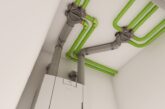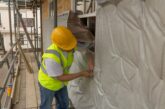
A five-bedroom self-build with no need for central heating is achieving impressive levels of thermal efficiency, thanks to Actis.
A Kent timber-frame specialist who has been busy using Actis Hybrid products for his customers has just completed his own new build – a five-bedroom house which is super cosy thanks to his use of the manufacturer’s entire range of insulation and membranes.

Andre Agard from A & S Carpentry says he hasn’t even had to put on the central heating in his detached house in Kingsgate but can still keep it a constant temperature of a cosy 19.5 degrees. This labour of love has been undertaken over the past year while the home counties builder has been doing the same high-quality job for paying customers.
By using insulating breather membrane Boost R Hybrid Roof,170mm honeycomb insulation Hybris and insulating vapour control layer H Control Hybrid he achieved a remarkable U-value of just 0.12 in the roof. And he reached a level of 0.18 in the walls by using 125mm Hybris and H Control Hybrid. Both these values far exceed those required under current building regulations, which demand 0.3 in the wall and 0.15 in the roof.
![]()
Andre was astounded to find that his house is far more airtight than he had anticipated. An airtightness test carried out to comply with Part L of the building regulations showed his build had achieved a level of 5.3m3/h/m2, even before installing the fireplace – rather than his estimate of 7m3/h/m2.
In order to comply with Part L1A, conservation of fuel and power, the air leakage from a house must not exceed 10m3/h/m2. This means that no more than 10 cubic metres of air can escape per hour for every square metre of the envelope surface area. By way of comparison, to achieve Passivhaus standard, it must attain 1m3/h/m2. A house which achieves 5m3/h/m2 – more or less what Andre’s attained – is estimated by the BRE, authors of the Building Regulations, to use 40 per cent less energy on heating than a house achieving a just compliant 10m3/h/m2 rating.
The fact that Actis products are flexible, can be squeezed into odd shaped gaps, and can be wrapped around corners, means thermal bridging is pretty much eliminated – leading, inevitably, to a more thermally efficient fabric envelope – the key to keeping the property warm in winter (and cool in summer).
An added bonus which Andre hadn’t been anticipating was that he can play his new sound system at full volume and it’s hardly audible at all outside – which is good news for his neighbours, of course!
Andre loved the process of working with the products as well as the final results.
“It was so much quicker and cleaner to install than the solid insulation I’ve used in the past and I’m now going to use Actis on all my future projects,” he said.
For further information on the range of solutions from Actis visit https://www.insulation-actis.com/







